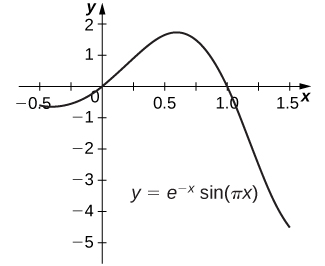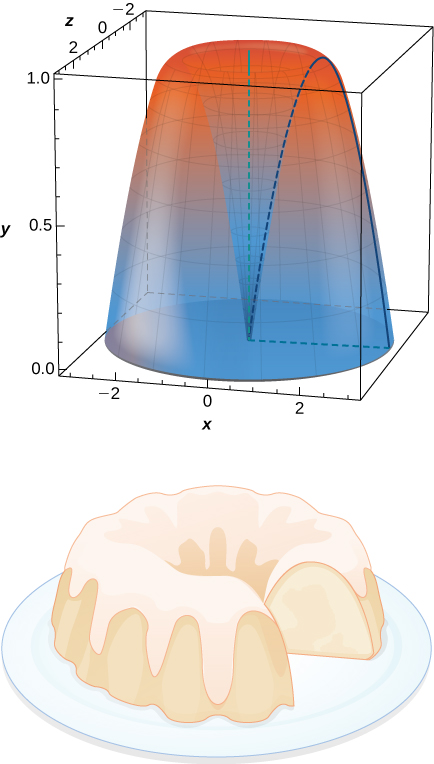8.1E: Exercises for Section 8.1
( \newcommand{\kernel}{\mathrm{null}\,}\)
In using the technique of integration by parts, you must carefully choose which expression is u. For each of the following problems, use the guidelines in this section to choose u. Do not evaluate the integrals.
1) ∫x3e2xdx
- Answer
- u=x3
2) ∫x3ln(x)dx
3) ∫y3cosydy
- Answer
- u=y3
4) ∫x2arctanxdx
5) ∫e3xsin(2x)dx
- Answer
- u=sin(2x)
In exercises 6 - 37, find the integral by using the simplest method. Not all problems require integration by parts.
6) ∫vsinvdv
7) ∫lnxdx (Hint: ∫lnxdx is equivalent to ∫1⋅ln(x)dx.)
- Answer
- ∫lnxdx=−x+xlnx+C
8) ∫xcosxdx
9) ∫tan−1xdx
- Answer
- ∫tan−1xdx=xtan−1x−12ln(1+x2)+C
10) ∫x2exdx
11) ∫xsin(2x)dx
- Answer
- ∫xsin(2x)dx=−12xcos(2x)+14sin(2x)+C
12) ∫xe4xdx
13) ∫xe−xdx
- Answer
- ∫xe−xdx=e−x(−1−x)+C
14) ∫xcos3xdx
15) ∫x2cosxdx
- Answer
- ∫x2cosxdx=2xcosx+(−2+x2)sinx+C
16) ∫xlnxdx
17) ∫ln(2x+1)dx
- Answer
- ∫ln(2x+1)dx=12(1+2x)(−1+ln(1+2x))+C
18) ∫x2e4xdx
19) ∫exsinxdx
- Answer
- ∫exsinxdx=12ex(−cosx+sinx)+C
20) ∫excosxdx
21) ∫xe−x2dx
- Answer
- ∫xe−x2dx=−e−x22+C
22) ∫x2e−xdx
23) ∫sin(ln(2x))dx
- Answer
- ∫sin(ln(2x))dx=−12xcos[ln(2x)]+12xsin[ln(2x)]+C
24) ∫cos(lnx)dx
25) ∫(lnx)2dx
- Answer
- ∫(lnx)2dx=2x−2xlnx+x(lnx)2+C
26) ∫ln(x2)dx
27) ∫x2lnxdx
- Answer
- ∫x2lnxdx=−x39+13x3lnx+C
28) ∫sin−1xdx
29) ∫cos−1(2x)dx
- Answer
- ∫cos−1(2x)dx=−12√1−4x2+xcos−1(2x)+C
30) ∫xarctanxdx
31) ∫x2sinxdx
- Answer
- ∫x2sinxdx=−(−2+x2)cosx+2xsinx+C
32) ∫x3cosxdx
33) ∫x3sinxdx
- Answer
- ∫x3sinxdx=−x(−6+x2)cosx+3(−2+x2)sinx+C
34) ∫x3exdx
35) ∫xsec−1xdx
- Answer
- ∫xsec−1xdx=12x(−√1−1x2+x⋅sec−1x)+C
36) ∫xsec2xdx
37) ∫xcoshxdx
- Answer
- ∫xcoshxdx=−coshx+xsinhx+C
In exercises 38 - 46, compute the definite integrals. Use a graphing utility to confirm your answers.
38) ∫11/elnxdx
39) ∫10xe−2xdx (Express the answer in exact form.)
- Answer
- ∫10xe−2xdx=14−34e2
40) ∫10e√xdx(letu=√x)
41) ∫e1ln(x2)dx
- Answer
- ∫e1ln(x2)dx=2
42) ∫π0xcosxdx
43) ∫π−πxsinxdx (Express the answer in exact form.)
- Answer
- ∫π−πxsinxdx=2π
44) ∫30ln(x2+1)dx (Express the answer in exact form.)
45) ∫π/20x2sinxdx (Express the answer in exact form.)
- Answer
- ∫π/20x2sinxdx=−2+π
46) ∫10x5xdx (Express the answer using five significant digits.)
47) Evaluate ∫cosxln(sinx)dx
- Answer
- ∫cosxln(sinx)dx=−sin(x)+ln[sin(x)]sinx+C
In exercises 48 - 50, derive the following formulas using the technique of integration by parts. Assume that n is a positive integer. These formulas are called reduction formulas because the exponent in the x term has been reduced by one in each case. The second integral is simpler than the original integral.
48) ∫xnexdx=xnex−n∫xn−1exdx
49) ∫xncosxdx=xnsinx−n∫xn−1sinxdx
- Answer
- Answers vary
50) ∫xnsinxdx=______
51) Integrate ∫2x√2x−3dx using two methods:
a. Using parts, letting dv=√2x−3dx
b. Substitution, letting u=2x−3
Challenge: Show the two answers are equivalent.
- Answer
- a. ∫2x√2x−3dx=23x(2x−3)3/2−215(2x−3)5/2+C
b. ∫2x√2x−3dx=(2x−3)3/2+15(2x−3)5/2+C
In exercises 52 - 57, state whether you would use integration by parts to evaluate the integral. If so, identify u and dv. If not, describe the technique used to perform the integration without actually doing the problem.
52) ∫xlnxdx
53) ∫ln2xxdx
- Answer
- Do not use integration by parts. Choose u to be lnx, and the integral is of the form ∫u2du.
54) ∫xexdx
55) ∫xex2−3dx
- Answer
- Do not use integration by parts. Let u=x2−3, and the integral can be put into the form ∫eudu.
56) ∫x2sinxdx
57) ∫x2sin(3x3+2)dx
- Answer
- Do not use integration by parts. Choose u to be u=3x3+2 and the integral can be put into the form ∫sin(u)du.
In exercises 58-59, sketch the region bounded above by the curve, the x-axis, and x=1, and find the area of the region. Provide the exact form or round answers to the number of places indicated.
58) y=2xe−x (Approximate answer to four decimal places.)
59) y=e−xsin(πx)
- Answer
- The area under graph is ππ2+1(e−1+1) units2.

In exercises 60 - 61, find the volume generated by rotating the region bounded by the given curves about the specified line. Express the answers in exact form or approximate to the number of decimal places indicated.
60) y=sinx,y=0,x=2π,x=3π; about the y-axis (Express the answer in exact form.)
61) y=e−x,y=0,x=−1,x=0; about x=1 (Express the answer in exact form.)
- Answer
- V=2πeunits3
62) A particle moving along a straight line has a velocity of v(t)=t2e−t after t sec. How far does it travel in the first 2 sec? (Assume the units are in feet and express the answer in exact form.)
63) Find the area under the graph of y=sec3x from x=0 to x=1. (Round the answer to two significant digits.)
- Answer
- A=12(sec(1)tan(1)+ln(sec(1)+tan(1)) ≈2.05units2
64) Find the area between y=(x−2)ex and the x-axis from x=2 to x=5. (Express the answer in exact form.)
65) Find the area of the region enclosed by the curve y=xcosx and the x-axis for 11π2≤x≤13π2. (Express the answer in exact form.)
- Answer
- A=12πunits2
66) Find the volume of the solid generated by revolving the region bounded by the curve y=lnx, the x-axis, and the vertical line x=e2 about the x-axis. (Express the answer in exact form.)
67) Find the volume of the solid generated by revolving the region bounded by the curve y=4cosx and the x-axis, π2≤x≤3π2, about the x-axis. (Express the answer in exact form.)
- Answer
- V=8π2units3
68) Find the volume of the solid generated by revolving the region in the first quadrant bounded by y=ex and the x-axis, from x=0 to x=ln(7), about the y-axis. (Express the answer in exact form.)
69) What is the volume of the Bundt cake that comes from rotating y=sinx around the y-axis from x=0 to x=π?

- Answer
- V=2π2 units3

